| HS Code | Official Doc | Tariff Rate | Origin | Destination | Effective Date |
|---|---|---|---|---|---|
| 9608300031 | Doc | 0.4¢ each + 2.7%+37.5% | CN | US | 2025-05-12 |
| 9608300039 | Doc | 0.4¢ each + 2.7%+37.5% | CN | US | 2025-05-12 |
| 9609904000 | Doc | 37.5% | CN | US | 2025-05-12 |
| 8206000000 | Doc | The rate of duty applicable to that article in the set subject t+30.0% | CN | US | 2025-05-12 |
| 8214100000 | Doc | 0.3¢ each + 4.2%+30.0% | CN | US | 2025-05-12 |
| 8214909000 | Doc | 1.4¢ each + 3.2%+30.0% | CN | US | 2025-05-12 |
| 3926100000 | Doc | 35.3% | CN | US | 2025-05-12 |
| 3924104000 | Doc | 33.4% | CN | US | 2025-05-12 |
| 3924905650 | Doc | 40.9% | CN | US | 2025-05-12 |




Drawing Tools
Drawing tools encompass a broad range of implements used to create images, diagrams, or markings on a surface. These tools vary significantly in their materials, intended purpose, and resulting aesthetic.
Materials
Drawing tools are constructed from diverse materials, influencing their characteristics and suitability for different applications. Common materials include:
- Graphite: Primarily used in pencils, graphite offers varying degrees of hardness (H) and softness (B), determining line darkness and smoothness.
- Carbon: Charcoal, made from burnt organic materials, produces rich, dark marks and is easily blendable.
- Pigments: Used in colored pencils, pastels, markers, and crayons, pigments provide color and opacity.
- Metal: Pens utilize metal nibs (steel, brass) for ink application, offering precision and durability.
- Plastic/Resin: Commonly found in pen casings, marker barrels, and some colored pencil components, providing structure and ease of use.
- Wood: Traditionally used for pencil casings, offering a comfortable grip and structural support.
Purpose
The purpose of a drawing tool dictates its design and application:
- Sketching: Tools for preliminary work, rapid ideation, and loose compositions (e.g., graphite pencils, charcoal).
- Detailed Illustration: Tools for precise rendering, refined lines, and intricate details (e.g., fineliner pens, colored pencils).
- Coloring: Tools for applying color to surfaces, ranging from broad coverage to subtle shading (e.g., crayons, pastels, markers).
- Technical Drawing: Tools for creating accurate diagrams, plans, and blueprints (e.g., drafting pencils, compasses, rulers).
- Calligraphy/Lettering: Tools for creating stylized handwriting and decorative lettering (e.g., calligraphy pens, brush pens).
Function
The function of a drawing tool is determined by its mechanism for depositing a marking substance:
- Lead/Core Deposition: Pencils rely on the friction of a graphite or colored lead core against a surface.
- Ink Flow: Pens utilize gravity, capillary action, or pressure to deliver ink from a reservoir to the nib.
- Pigment Transfer: Crayons, pastels, and charcoal transfer pigment directly from the stick to the surface.
- Liquid Application: Markers use a porous tip to deliver liquid pigment or dye.
Usage Scenarios
Drawing tools are employed in a wide array of settings:
- Artistic Creation: Fine art, illustration, comics, manga, animation.
- Design & Architecture: Sketching concepts, creating blueprints, rendering models.
- Engineering & Drafting: Creating technical drawings, schematics, and plans.
- Education: Learning to draw, visual communication, note-taking.
- Everyday Use: Writing, doodling, labeling, coloring.
Common Types
- Pencils: Graphite pencils (HB, 2B, 4B, etc.), colored pencils, mechanical pencils.
- Pens: Ballpoint pens, gel pens, fineliner pens, fountain pens, calligraphy pens, brush pens, marker pens (permanent, watercolor, chisel tip, broad tip).
- Charcoal: Vine charcoal, compressed charcoal, charcoal pencils.
- Pastels: Soft pastels, oil pastels, pastel pencils.
- Crayons: Wax crayons, oil pastels (overlap with pastels).
- Digital Drawing Tools: Styluses for tablets and touchscreens, drawing software.
Drawing tools encompass a variety of items, including pencils, crayons, pastels, drawing charcoals, and writing or drawing chalks, used for creating sketches, illustrations, and markings. These tools are utilized in artistic, educational, and professional settings.
The following HS codes are relevant to drawing tools, based on the provided reference material:
- 9608300031: This HS code covers ball point pens, felt tipped and other porous-tipped pens and markers, fountain pens, stylograph pens and other pens, duplicating styli, propelling or sliding pencils (for example, mechanical pencils), pen-holders, pencil-holders and similar holders, and parts (including caps and clips) of the foregoing articles, other than those of heading 9609, specifically fountain pens, stylograph pens and other pens India ink drawing pens. The applicable tax rate is a base duty of 0.4¢ each + 2.7%, with an additional 7.5% duty, increasing to 30.0% after April 2, 2025, resulting in a total tax rate of 0.4¢ each + 2.7% + 37.5%.
- 9608300039: This HS code also covers ball point pens, felt tipped and other porous-tipped pens and markers, fountain pens, stylograph pens and other pens, duplicating styli, propelling or sliding pencils (for example, mechanical pencils), pen-holders, pencil-holders and similar holders, and parts (including caps and clips) of the foregoing articles, other than those of heading 9609, but categorized as "Other". The applicable tax rate is a base duty of 0.4¢ each + 2.7%, with an additional 7.5% duty, increasing to 30.0% after April 2, 2025, resulting in a total tax rate of 0.4¢ each + 2.7% + 37.5%.
- 9609904000: This HS code covers pencils (other than those pencils of heading 9608), crayons, pencil leads, pastels, drawing charcoals, writing or drawing chalks and tailors' chalks, specifically categorized as "Other: Tailors' chalks". The applicable tax rate is a base duty of 0.0%, with an additional 7.5% duty, increasing to 30.0% after April 2, 2025, resulting in a total tax rate of 37.5%.
Customer Reviews
No reviews yet.